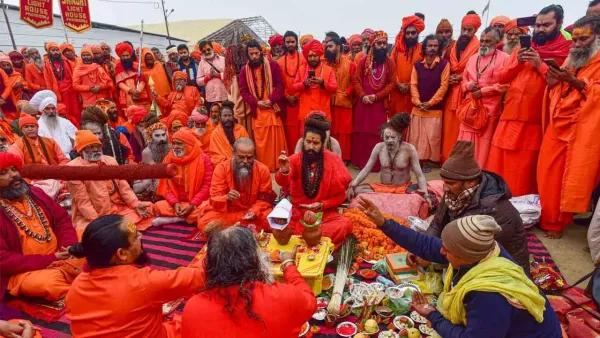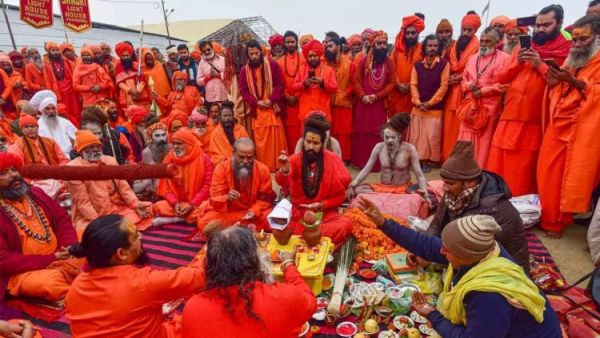
In an effort to complete the preparations for the Maha Kumbh starting on January 13, the whole Uttar Pradesh state apparatus has gathered in Sangam, the holy meeting point of the Ganga, Yamuna, and the fabled Saraswati river in Prayagraj, as 2024 comes to an end.

In preparation for one of the biggest religious gatherings in the world, a team of laborers has been hard at work for the last two months leveling the ghats, enlarging the roadways, and diverting the rivers.
Prime Minister Narendra Modi called the massive gathering the “Maha Kumbh of unity” while addressing his monthly “Mann ki Baat” program on Sunday. He encouraged everyone to leave the large gathering determined to eradicate hatred and division from society. The prime minister said, “Maha Kumbh ka sandesh, ek ho pura desh” (Message from Maha Kumbh — whole nation should unify), noting that the uniqueness of Maha Kumbh is not just its expanse but also its diversity. Starting on ‘Paush Poornima’ on January 13 and ending on ‘Maha Shiv-ratri’ on February 26 after 45 days, the Maha Kambh is held every 12 years.
This year, the state administration anticipates that an incredible 40 crore devotees would take the holy plunge, making the Maha Kumbh the biggest religious event in the world. The celebration attracts millions of pilgrims to the banks of the Ganga at Sangam. Thorough preparation and vast logistics are part of the enormous work of getting ready for such an event.
In order to completely transform the region, the authorities are supervising the construction of 160,000 tents, 150,000 toilets that will be maintained by 15,000 sanitation personnel, 1,250 kilometers of pipeline, 67,000 LED lights, 2,000 solar lights, and 300,000 plants. Additionally, 12 km of temporary ghats are being built, along with seven riverside roads and nine paved ghats. More than 1.5 million square feet of street art and murals have been commissioned to decorate the arena, and seven bus stops are also being constructed.
But the enormous undertaking is not without its difficulties. The Ganga has shifted from its natural path due to erosion, which has also reduced the amount of land accessible for the Maha Kumbh. Additionally, 3,200 hectares of land needed for the 2019 Kumbh were engulfed by river encroachment over the course of five years. To guarantee that the event’s scope is as magnificent as ever, authorities have stepped up to the plate and reclaimed the 3,200 hectares in addition to an extra 800 hectares.
The preparation of 4,000 hectares of land is an accomplishment in and of itself. “Even if you begin preparations six months in advance for a wedding, work continues until the moment the ‘baraat’ arrives,” a senior official said in response to a question about whether the preparations will be finished by January 10. He compared the labor to the planning of a large Indian wedding.
However, the official gave assurances that everything will be prepared on time. Experts from the irrigation department, working with the Indian Institute of Technology, Guwahati, began diverting the rivers to construct more ghats for the inflow of pilgrims in October, marking the start of the area’s preparations.
Land along the banks had been severely diminished due to erosions at Sangam, and the Ganga was moving between 200 and 500 meters. “The Ganga has moved significantly between 2019 and 2024, decreasing the available land for the Kumbh,” said Vijay Kiran Anand, Mela Adhikari (fair in-charge). The pace of activity has accelerated with just two weeks left until Makar Sankranti, when the first auspicious dip, or “Rajasi Snan,” will occur.
Groups of laborers are building barriers, shelters, and temporary facilities as soon as one drives into the Sangam region, while artists are painting colorful murals and welcoming messages on the walls. For the Uttar Pradesh administration, the occasion is a matter of status rather than just another religious celebration. Just as much attention is being paid to the preparations as to the dedication of the Ram Temple in Ayodhya earlier this year.
This time, the administration is likewise setting greater goals. According to Chief Minister Yogi Adityanath, around 40 crore pilgrims are anticipated to attend the Maha Kumbh this year, compared to over 24 crore in 2019. The 4,000-hectare Kumbh land has been split into 25 parts on both banks of the river to accommodate this extraordinary migration. Thirty pontoon bridges are being built, eight more than in 2019, to guarantee a smooth movement of devotees. In addition to constructing a vast 1,250-kilometer pipeline network that will provide more than 50,000 water connections, the public works department (PWD) is working hard to renovate 90 highways.
Along with 200 water ATMs strewn over the grounds and 84 light poles, 67,000 LED lights will also be used to brighten the area. 150 “Ganga Sewa Doots,” or volunteers, and 15,000 sanitation workers will be on duty to maintain cleanliness. Additionally, banks and automated teller machines will be available in each of the 25 sectors to facilitate easy financial transactions, and pilgrims will be drawn in by food courts and kid-friendly entertainment zones. A 100-bed central hospital, two 20-bed sub-center hospitals, 25 first-aid stations, and 125 ambulances on standby are all part of the administration’s major emphasis on healthcare. To help with the efforts, the All India Institute of Medical Sciences in Rae Bareli has been called upon.
The 13 “Akhadas,” or religious groups, that are essential to the Kumbh have already established their encampment and raised their flags as religious songs are sung. Applications for Akhada allocations are initially being accepted online, however those who took part in the 2019 Kumbh will be given preference. Prayagraj is a hive of activity as the Sangam is being turned into a temporary city with just a few days till the Maha Kumbh begins.